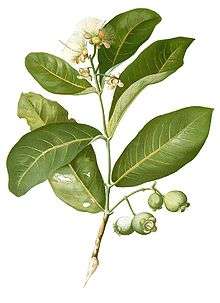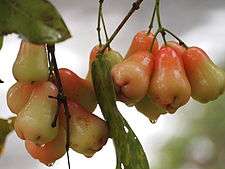Syzygium aqueum
Syzygium aqueum is a species of brush cherry tree. Its common names include watery rose apple;[2] names like "water apple" and "bell fruit" may refer to any species of Syzygium grown for its fruit.
| Syzygium aqueum | |
|---|---|
 | |
Rare (NCA) | |
| Scientific classification | |
| Kingdom: | Plantae |
| Clade: | Tracheophytes |
| Clade: | Angiosperms |
| Clade: | Eudicots |
| Clade: | Rosids |
| Order: | Myrtales |
| Family: | Myrtaceae |
| Genus: | Syzygium |
| Species: | S. aqueum |
| Binomial name | |
| Syzygium aqueum | |
| Synonyms[1] | |
| |

The tree is cultivated for its wood and edible fruit. The fruit is a fleshy yellow or red berry which is bell shaped, waxy and crisp.
Syzygium aqueum is native to Malesia, New Guinea and Queensland.[1] The tree requires heavy rainfalls and can survive in tropical habitats, up to 1600m from sea level.[3] In the Philippines, it is locally known as tambis and is often confused with macopa (Syzygium samarangense).[4]
The wood is hard and can be used to make tools. The bark of the tree is sometimes used in herbal medicines. It is grown in orchards and gardens and parks as an ornamental plant. The leaves are edible and are sometimes used to wrap food.
The fruit has a very mild and slightly sweet taste similar to apples, and a crisp watery texture like the inside of a watermelon. It is a staple of Southeast Asian fruit stands, where it is inexpensive while in season. It does not bruise easily and may be preserved for months in a household refrigerator.
References
- "Syzygium aqueum". World Checklist of Selected Plant Families (WCSP). Royal Botanic Gardens, Kew. Retrieved 16 July 2018.
- "Syzygium aqueum". Germplasm Resources Information Network (GRIN). Agricultural Research Service (ARS), United States Department of Agriculture (USDA). Retrieved 26 January 2017.
- [French, Bruce R. 1989. Food plants of Papua New Guinea : a compendium.].
- Janick, Jules; Paull, Robert (2008). The Encyclopedia of Fruits and Nuts. CABI. pp. 552, 553. ISBN 9780851996387.